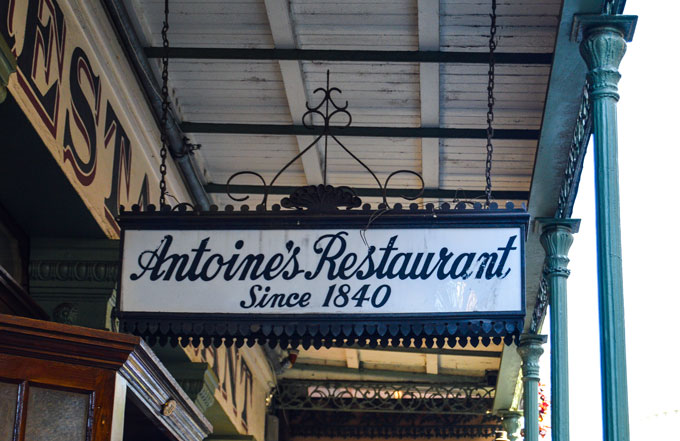
When planning a visit to New Orleans, the place that ranked number one on my must-see list was Antoine’s Restaurant in the French Quarter. With my love of cooking and history, how could it not be? Antoine’s Restaurant launched operations in 1840, so it has a historical pedigree uncommon in the United States. It can also claim many culinary firsts, like creating the famed Oysters Rockefeller, since Antoine Alciatore began what still remains his family’s business today.
I didn’t waste time scheduling a lunch trip to the restaurant and found myself standing across from it on St. Louis Street about 21 hours after landing at New Orleans International Airport. The outside of Antoine’s has everything you would expect to see in a traditional 1800s French Quarter building: elegantly tall double doors, lacey wrought iron, and a second floor gallery with lush hanging planters reminding you that you are in a subtropical climate. Its blend of French architectural style and real-world references to its southern location promised an interesting tasting experience once you passed through its entrance. To intensify the harkening back to the past, a horse-drawn carriage even clop-clopped past while I took pictures of the restaurant’s exterior.
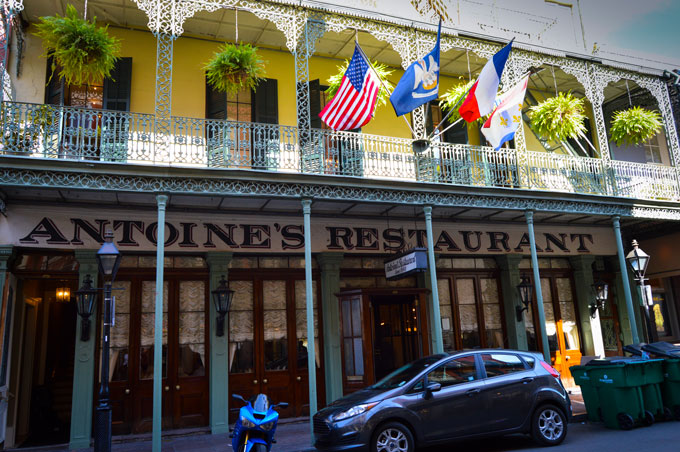
Although Antoine’s looks like a medium-sized restaurant from the outside, I knew from research that it has many distinct dining rooms hidden within. My lunch party was able to choose whether we wanted to dine in the Main Dining Room or the Annex that is located further back from the restaurant’s entrance. We chose the Annex. After lunch, our very gracious and knowledgeable waiter encouraged my party to take a tour of the restaurant, so I’ll get back to discussing the different dining rooms later. But now, onto the food.
Having a Lunch, or Two, at Antoine’s
Sitting down to order at Antoine’s provides proof that New Orleans offers some of the best foods in the country–even the complementary French bread served before the meal was worth noting. Freshly-baked, it had just the right texture: puffy and soft on the inside with an exterior that was crusty, but not so crusty that it wrecks the roof of your mouth when you bite into it. I like a lot of the artisan-style breads you can buy these days, but sometimes the crusts are entirely too rough and tough. The French bread at Antoine’s and other places in New Orleans wasn’t like that. Instead, it was steamed just enough when put in the oven to give it a glossy crust that still remained malleable. Washing it down with the Daily Special Lemon Drop cocktail made it just right for sightseeing-weary travelers in the middle of a long day.
First Course – Facing an Old Fear
For the first course, I chose the Charbroiled Oysters, which was a risk in my mind. I only had oysters once before and I thought they were so horrible, I questioned whether I could ever chance trying them again. Like, even if they were free, I might say, “Thanks, but no thanks.” But the fact that Antoine’s was famous for its oyster dishes made me think, “If you’re ever going to give them a second chance, do it now.” Boy, I’m glad I did.
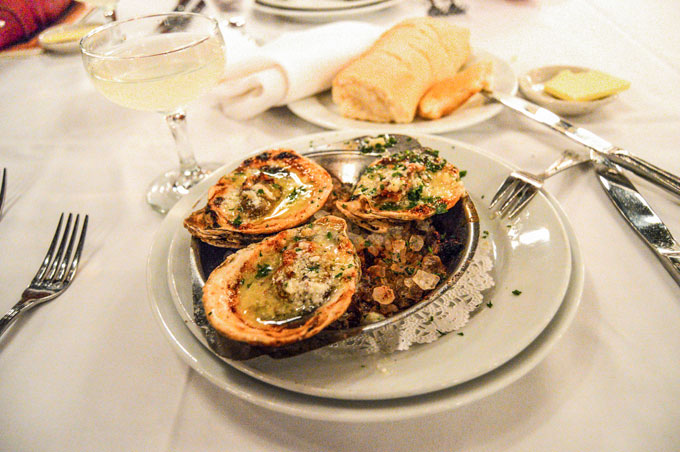
The Charbroiled Oysters were sublime and have now become one of my favorite dishes. Broiled with seasoned garlic, herbs, butter, olive oil, and Romano cheese, the oysters were served on a bed of rock salt. The way the melted Romano cheese perfectly complemented the juicy oysters underneath lays waste to the often repeated mantra from cooking experts that you should never use shellfish and cheese in the same dish. On the contrary, you should, especially in this case.
Second Course – French and Creole Influences
My second course was Veal Royale served with a roasted tomato sauce on a bed of pecan and onion rice. The veal was prepared in the classic escalope style: tenderized slightly by pounding, then lightly coated with flour and fried. The roasted tomato sauce added a palate-cleansing acidity to the dish and the pecans in the savory rice provided a nice crunch.
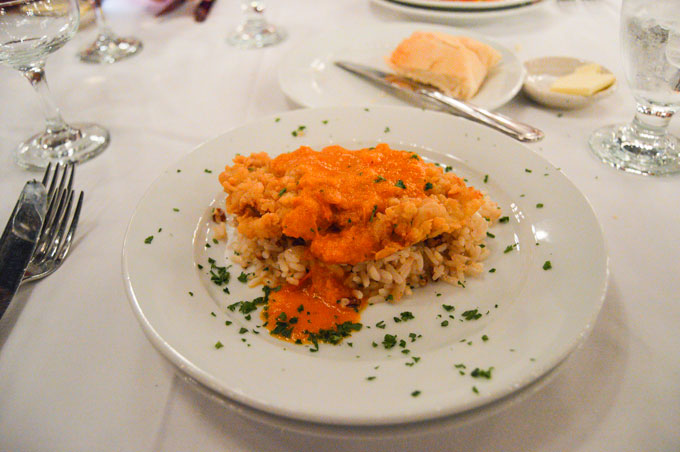
One of my lunch companions made a point of ordering Antoine’s Creole Shrimp and Grits, because if you are going to try something as finicky as grits for the first time, you want them prepared by someone who can do them right. Throughout the rest of our trip in New Orleans, we had a number of other restaurants’ grits, but Antoine’s was by far the best. Prepared with sautéed garlic and cheese, the grits at Antoine’s had a medium-coarse texture, so I think they were prepared with old-fashioned grits, as opposed to the coarser Hoppin’ John-style grits or the finer-style quick grits. They were a perfect base for the Creole Shrimp, which was prepared with a slightly-spiced, tomato-based sauce.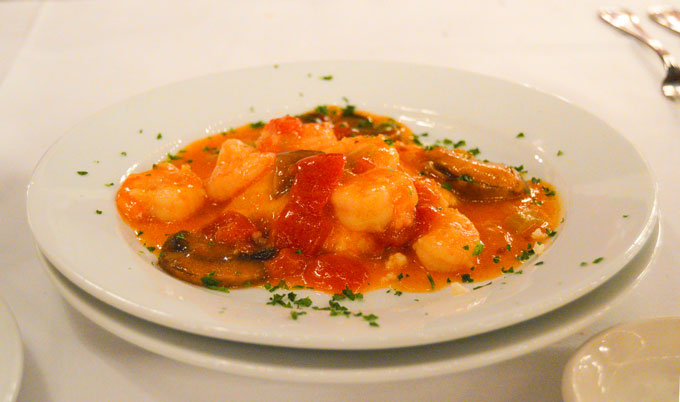
Third Course – An Old Southern Favorite
When deciding on dessert, I had to stick with a Southern classic: bread pudding. Antoine’s bread pudding featured cinnamon, raisins, and pecans and was topped with a praline rum sauce. The texture of the bread pudding was just right—firm, but not dense. Each mouthful had a little hidden surprise in the form of either the soft raisins or the crunchy pecans. The bread pudding wasn’t too sweet, so the praline rum sauce poured on top resulted in an interplay of contrasting sugar levels within each bite.
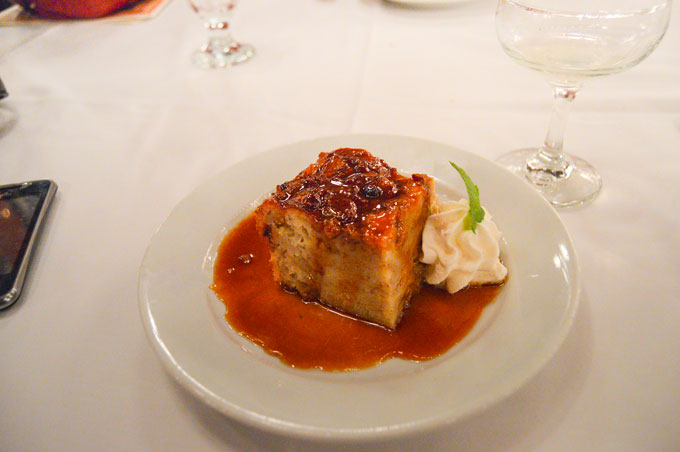
Eat and Repeat
My lunch party enjoyed our experience at Antoine’s so much that we went back to the restaurant a couple of days later. Rather than returning to food again after I discuss touring the restaurant at the end of our first visit, I thought it would be best to discuss our second lunch now. I again ordered the oysters for the appetizer and bread pudding for dessert, but for the main dish, I opted for the Bordeaux Petit Filet. The petit filet was melt-in-your-mouth soft and served over rich Yukon mashed potatoes, smothered in a mushroom and onion cabernet sauce. The dish proved one of my growing suspicions about cooking: booze in foods makes foods better.
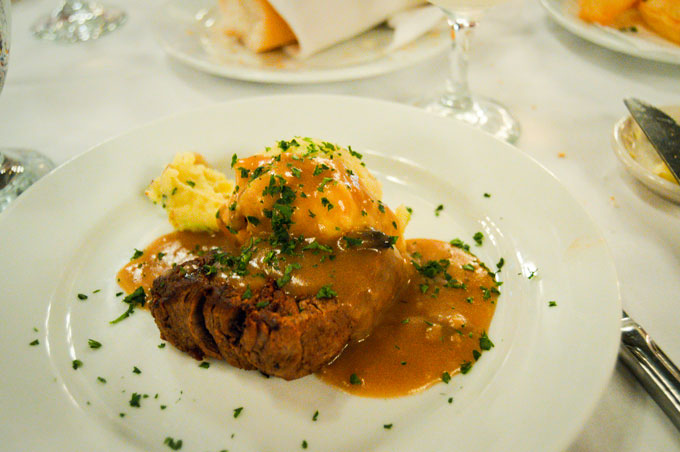
The Tater Hybrid
On this second lunch visit, I also ordered an extra treat that I waited a long time to sample. Here’s the background story: I was a big fan of a series called Great Chefs that was shown years ago on the Discovery Channel, before the Discovery Channel turned into Watch-Dudes-Doing-Their-Jobs Reality TV Central. The series visited the kitchens of note-worthy chefs across the world, so you could see the chefs prepare specific dishes step-by-step. (Jeez, maybe the Watch-Dudes-Doing-Their-Jobs theme started a lot earlier than I thought on Discovery…) Some of the shows in the series were titled Great Chefs of New Orleans and I remember the production visited Antoine’s Restaurant. I believe one of the dishes featured on that episode was Pommes de Terre Soufflées, also known as Fried Puffed Potatoes, which had been offered at the restaurant since the 1840s. When I saw the dish on the menu, I had to order it.
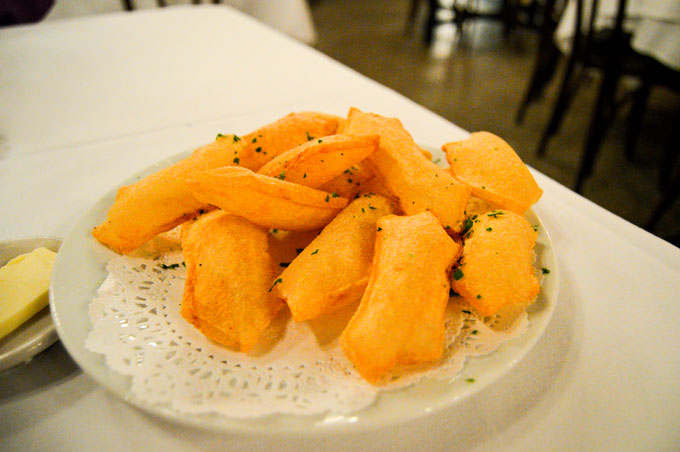
Pommes de Terre Soufflées is like a potato chip and a French fry had a baby. Thin slices of potatoes are double fried in two different temperatures of oil and the process makes the potato slices puff up so they become hollow. As you can see in the following picture, they are like a potato chip pillow. The crispy exterior contains some soft potato inside, so the French fry part of the equation doesn’t disappear without letting its presence be known. I thought they were delicious and it was so interesting eating something that seemed so familiar, but was different. The next time I return to Antoine’s, I would love to order them again with some Alciatore or Bearnaise sauce on the side.
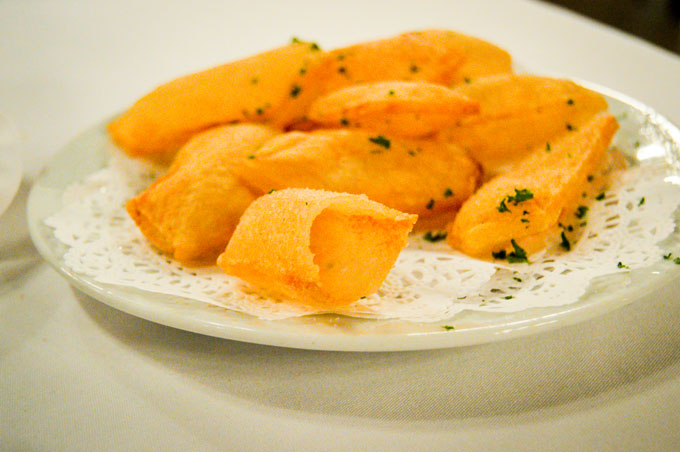
Wandering Through History
As I mentioned before, the waiter at our first lunch invited us to take a look at the rest of Antoine’s rooms when he learned it was our first visit to the restaurant. I took many pictures to share in this post, but it was impossible to get some images without including other diners. And since I do respect people’s privacy, it was a conundrum figuring out how to show the pictures without exposing fellow patrons to the red-hot, merciless glare of the internet’s prying eyes. Blurring out faces was an option, I guess, but it just wouldn’t do. No, this was New Orleans and its famous Mardi Gras gave me a perfect solution: give everyone in the pictures a Mardi Gras mask.
So, this is the Main Dining Room, with my made-up Mardi Gras revelers. It is the first room you see when you enter the restaurant from St. Louis Street as the horse-drawn carriages clop-clop by:
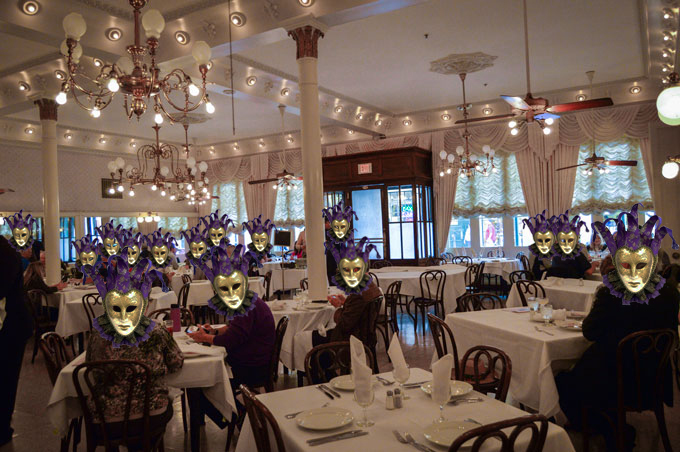
The following is the Annex, where my party ate both times we visited the restaurant. The pictures on the walls and columns are of famous people who have visited the restaurant; these pictures of celebrities and notables are found throughout many of the other dining rooms.
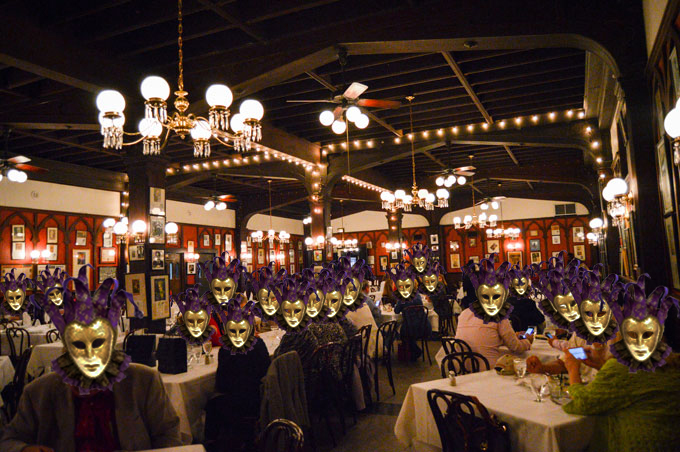
At the back of the Annex is a hallway that leads to more dining rooms and the wine cellar—love those crystal chandeliers and the pictures of Mardi Gras celebrations long past.
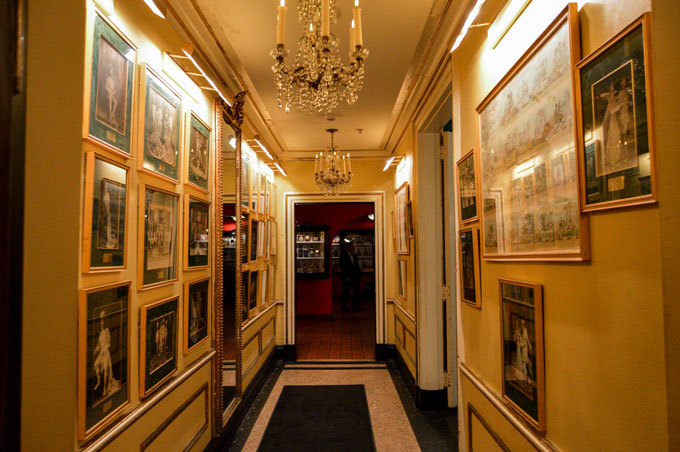
The majestic Rex Room, named for one of the Krewes in the Mardi Gras Parade:
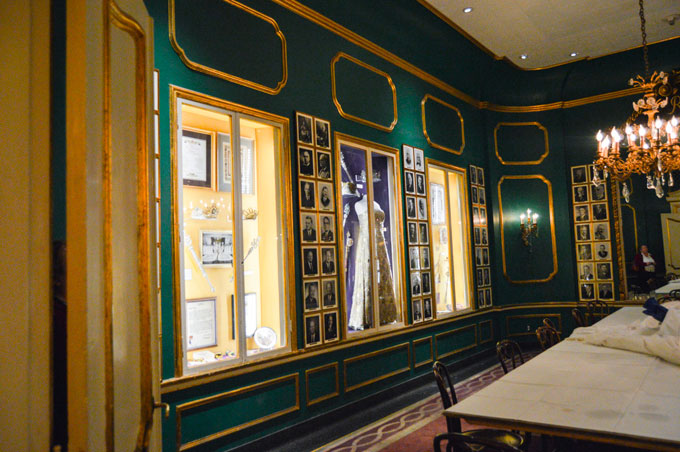
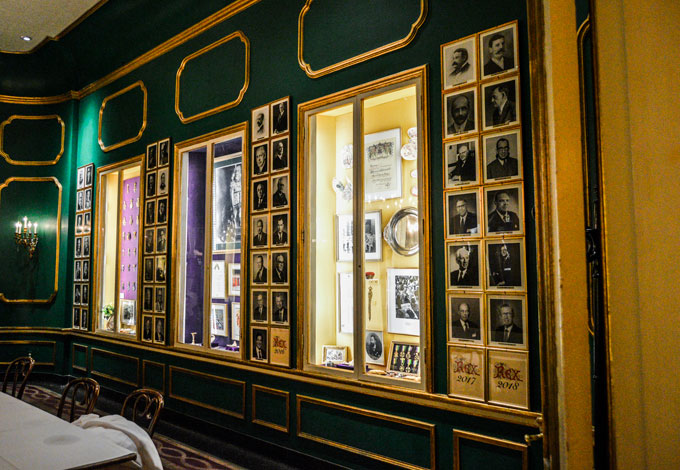
The Proteus Room is the second of three rooms named in honor of Krewes from Mardi Gras. Unfortunately, I have no pictures of the third, the Twelfth Night Revelers Room, which is located on the restaurant’s second floor.
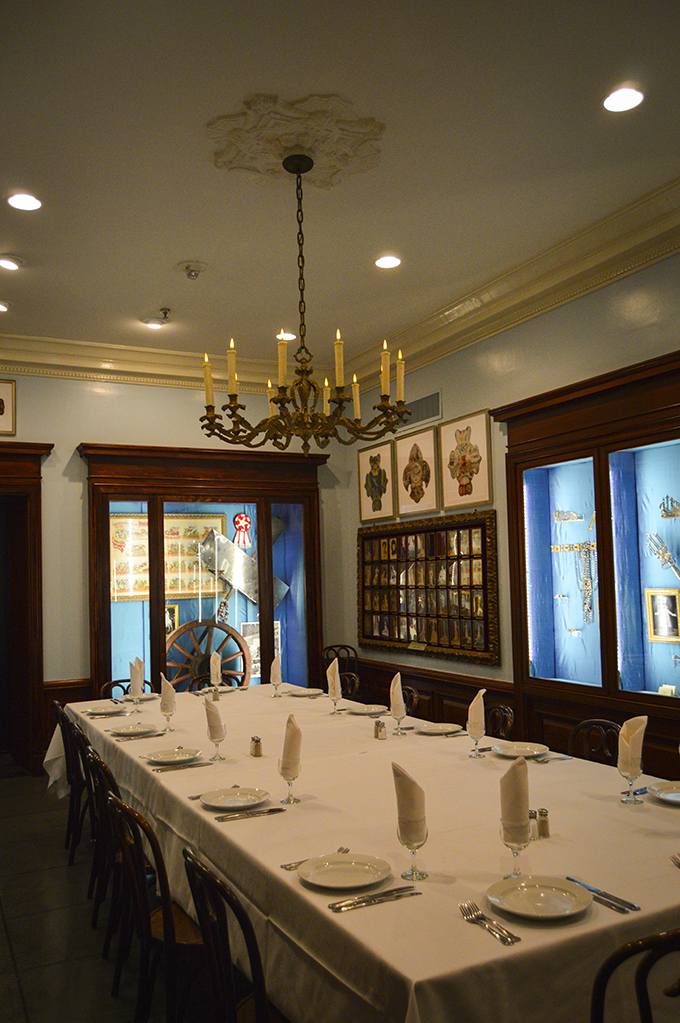
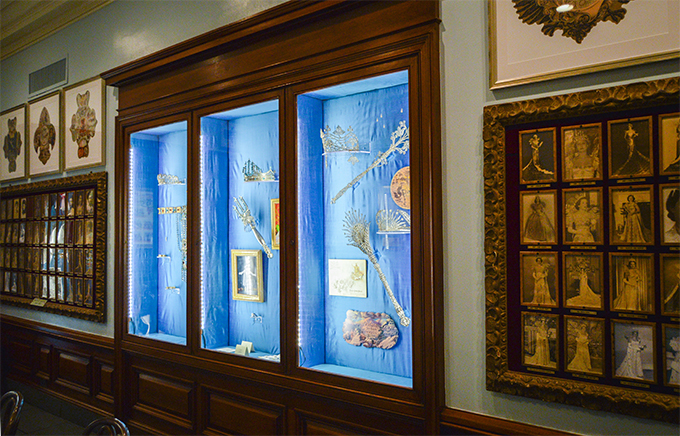
The Wine Cellar, and yes, that’s a real cannon:
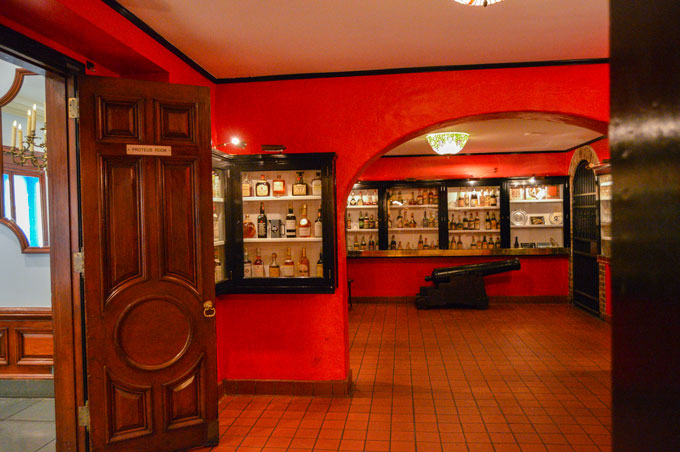
The Dungeon, an intimate dining room with a welcoming atmosphere that defies its name:
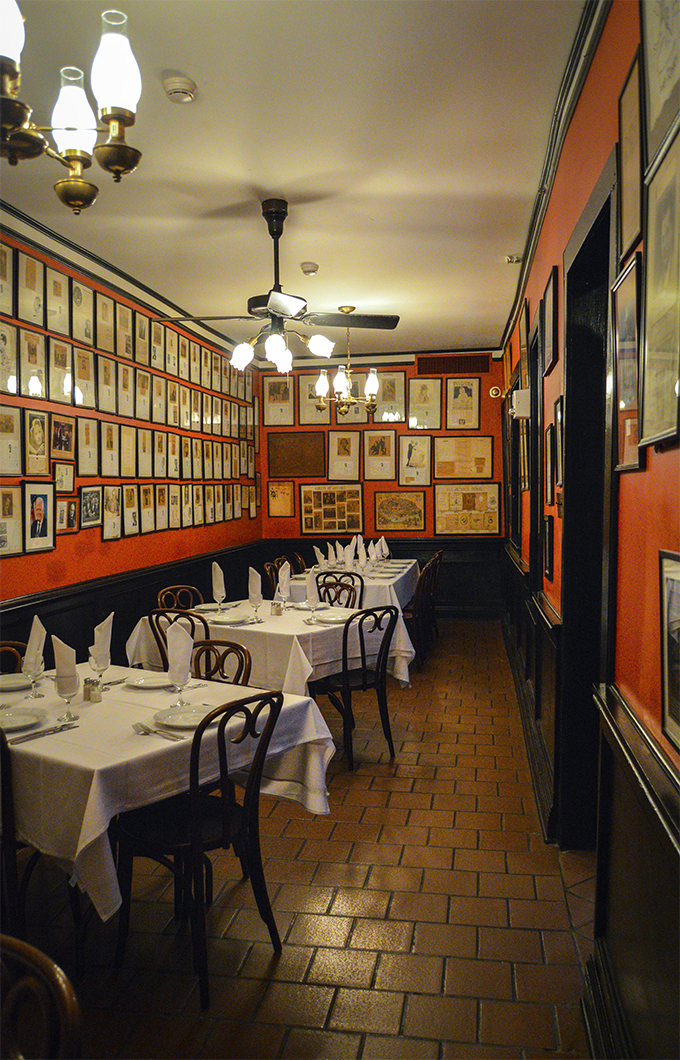
In the left corner of the Dungeon, I found a picture of a personal favorite: Errol Flynn. Oh Errol, you rapscallion, you!
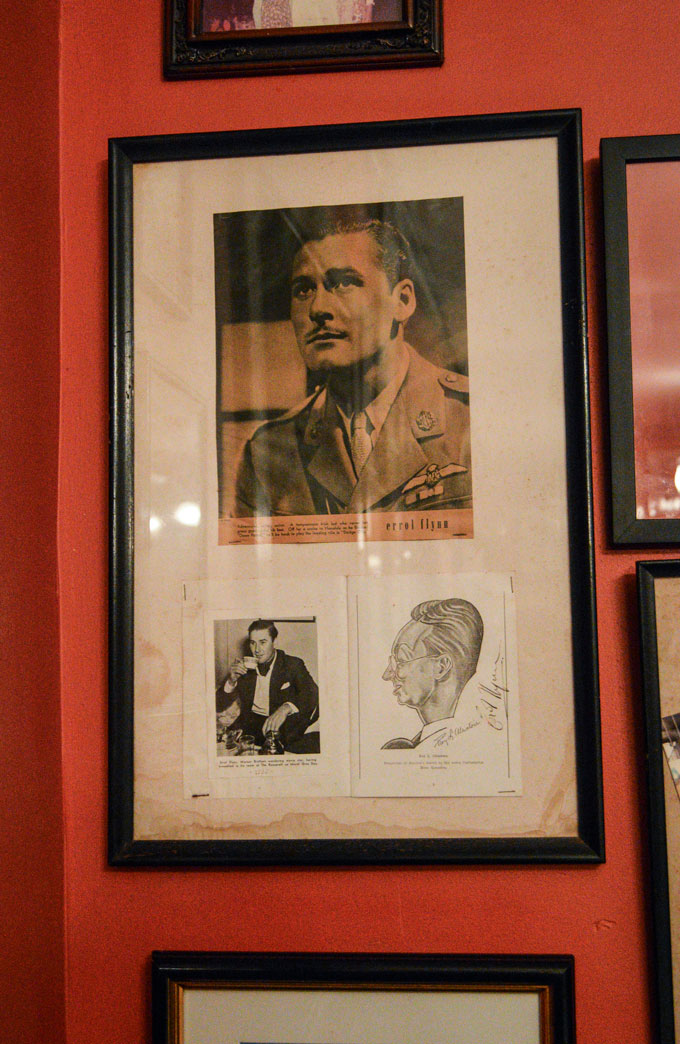
The hallway outside the Dungeon, which leads to the 1840 Room. Sadly, all the pictures I took of the 1840 Room were a little too blurry to include in this post.
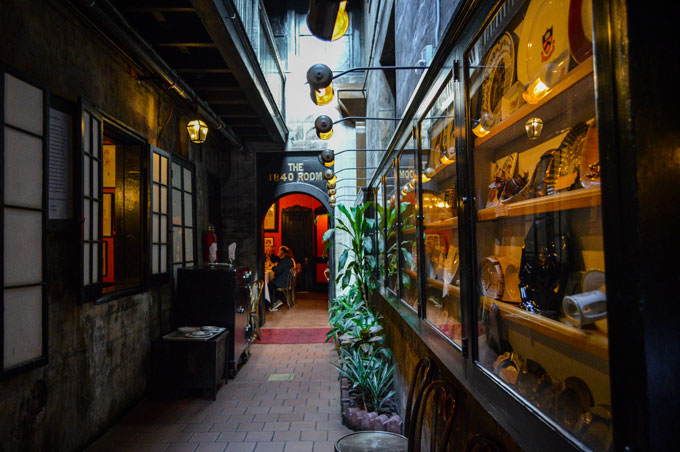
A visit to Antoine’s Restaurant combines great food, prepared and served with care, and a tangible, concrete experience of living history. Although you might get the impression from the above pictures that the restaurant has a museum-like quality, it is an active, vibrant business. So instead of feeling like you are a spectator to history, as you would in a museum, you actually become a participant in history when you walk through Antoine’s doors. And what a storied and delicious history it is.
Leave a Reply